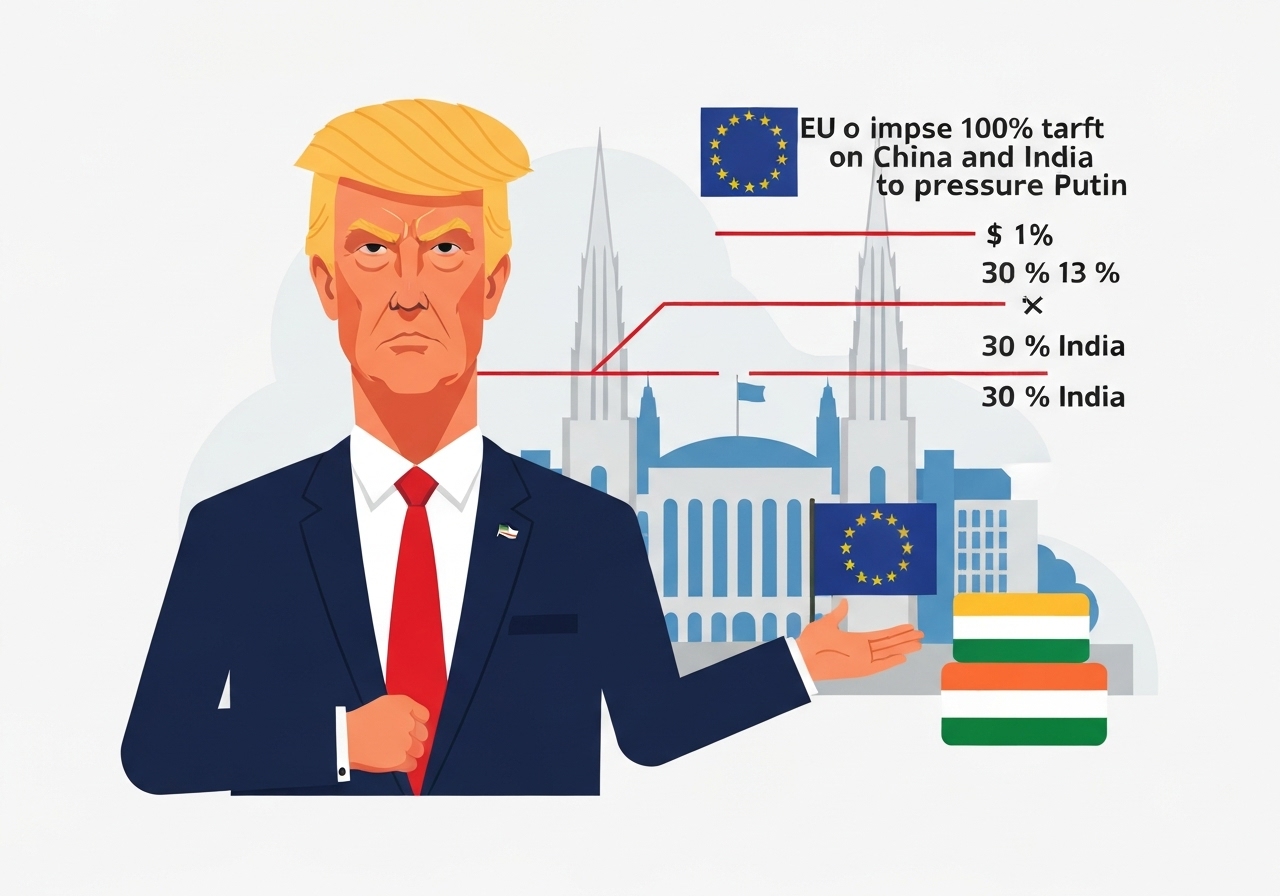US President Donald Trump has urged the European Union to impose tariffs as high as 100% on goods from China and India as part of a strategy to increase economic pressure on Russia and compel President Vladimir Putin to end the war in Ukraine. The request — first reported by the Financial Times and confirmed to the BBC by a source familiar with the talks — was made during a meeting between US and EU officials on Tuesday exploring options to squeeze Russia’s economy. The appeal comes amid intensified Russian strikes on Ukraine, including a recent missile attack on a main government building in Kyiv and a weekend barrage that Ukrainian authorities said involved at least 810 drones and 13 missiles. Trump also told reporters he plans to speak with Mr Putin this week or early next week as he seeks a negotiated settlement.
Key Takeaways
- Trump requested the EU consider tariffs up to 100% on imports from China and India to increase leverage over Russia; the proposal was raised in a US-EU meeting on Tuesday.
- Ukraine reported that the weekend bombardment used at least 810 drones and 13 missiles, and that more than 20 civilians were killed by a glide bomb in Donbas.
- Last month the US imposed a 50% tariff on certain Indian goods, including a 25% penalty tied to transactions with Russia.
- The EU still sources about 19% of its natural gas from Russia, underscoring the bloc’s energy exposure even as it aims to reduce dependence.
- Trump said he expects to speak with Indian Prime Minister Narendra Modi soon and described ongoing negotiations to address trade barriers.
Background
The war in Ukraine has prompted Western governments to deploy sanctions and export controls meant to isolate Russia economically and limit Moscow’s ability to sustain its military campaign. Since February 2022, the United States and EU members have applied multiple rounds of financial, trade and technology restrictions targeting Russian banks, oligarchs and critical industries. China and India remain major purchasers of Russian oil and other commodities, which analysts say have softened the full impact of Western sanctions on Moscow.
European policy has so far leaned toward sanctions and restrictions designed to constrain Russian access to technology and finance rather than broad trade levies against third-party buyers. Energy ties complicate any escalation: the EU’s roughly 19% reliance on Russian gas — a figure that varies by member state — has been a central factor shaping Brussels’ approach to coercive measures. Past talks between the White House and EU officials have focused on how to tighten export controls, reduce Russia’s oil revenues and limit circumvention of sanctions.
Main Event
According to a source briefed on the meeting, Mr Trump raised the prospect of the EU imposing very high tariffs — up to 100% — on imports from China and India to create additional economic pressure on Moscow. The proposal was discussed during a bilateral session on Tuesday that reviewed tools available to increase costs for the Russian government and its backers. Officials did not announce any binding commitments during the meeting, and Brussels has not publicly accepted the plan.
The proposal takes place as Mr Trump seeks to broker talks between Moscow and Kyiv after a summit in Alaska last month that concluded without an agreement. Mr Trump has said publicly he will speak with President Putin imminently and has framed tariffs as part of a broader negotiation posture. Separately, he said the US and India are “continuing negotiations to address the Trade Barriers” and that he plans to speak with Prime Minister Narendra Modi about reaching a successful outcome.
Russian strikes over the weekend hit Kyiv’s central government building and produced what Ukrainian officials described as the largest aerial bombardment since the start of the full-scale invasion. Ukraine reported at least 810 drones and 13 missiles were used during the attacks, and local authorities said a glide bomb killed more than 20 civilians in the eastern Donbas region as they waited for pensions. Trump reacted to the bombardment by saying he was ‘not happy with the whole situation’ and warning of harsher sanctions if the Kremlin continued its escalation.
Analysis & Implications
If the EU were to adopt tariffs of the magnitude Mr Trump suggested, it would represent a sharp shift from its current sanctions-first strategy and could trigger broad geopolitical and economic consequences. High tariffs on China and India would not directly target Russia but aim to pressure two of its largest commodity buyers to reduce energy and goods flows — a step that could further disrupt global trade patterns and supply chains. Such a policy risks retaliation or escalation from affected trading partners, and would require near-unanimous agreement among EU member states to implement.
Economically, 100% tariffs would raise import prices dramatically, likely increasing costs for European consumers and manufacturers that rely on intermediate goods from China and India. Policymakers would have to weigh potential gains in leverage over Russia against the risk of inflationary pressure and supply shortages across EU markets. Member states with significant trade exposure to China or India may resist a measure that could harm their own exporters or damage industrial competitiveness.
Politically, the plan would test diplomatic ties between Washington, Brussels, Beijing and New Delhi. India has been moving closer to the United States on strategic issues in recent years, but trade disputes have periodically strained relations. Beijing would almost certainly view sweeping tariffs as hostile and could respond with countermeasures affecting European and US interests. The proposal therefore carries a high diplomatic cost even if its promoters argue it would indirectly choke off revenue streams to Moscow.
Comparison & Data
| Metric | Recent Figure |
|---|---|
| Ukraine: reported drones used in recent attacks | 810 drones |
| Ukraine: reported missiles used in recent attacks | 13 missiles |
| US tariff recently applied to some Indian goods | 50% (including 25% Russia-related penalty) |
| EU imports of natural gas from Russia | ~19% of total EU gas imports |
These numbers illustrate two concurrent dynamics: the intensification of Russian strikes on Ukraine and the evolving toolkit of economic measures considered by Western capitals. The reported scale of the attacks — hundreds of drones and over a dozen missiles — has reinforced calls in some quarters for tougher measures on Russia and its economic partners. Conversely, the scale of trade flows between Russia, China and India complicates attempts to sever those ties without wider economic fallout.
Reactions & Quotes
Officials and commentators offered swift reactions to the reports, reflecting the political complexity of the proposal and the differing priorities among stakeholders.
“I’m not happy with the whole situation,”
US President Donald Trump, to reporters
Trump used that remark after the weekend bombardment and framed potential harsher sanctions as a response to Russia’s recent actions. The comment signaled his readiness to escalate pressure if diplomatic channels fail.
“Washington is prepared to escalate economic pressure but needs stronger European backing,”
US Treasury official cited in reporting
That summary — attributed to US Treasury commentary during the talks — underscores an American assessment that punitive measures will be most effective with broad European alignment.
“Our teams are working to conclude these discussions at the earliest,”
Indian Prime Minister Narendra Modi, social media post
Mr Modi’s response to Mr Trump’s public remarks emphasized the two countries’ ongoing trade talks and diplomatic rapport, while avoiding commitment to any third-party targeting of Russia.
Unconfirmed
- There is no public confirmation from the European Union that it will adopt the 100% tariff proposal; discussions were reported but no decision has been announced.
- Trump’s reported timetable for a phone call with President Putin — ‘this week or early next week’ — has not been independently verified at the time of reporting.
- Specific details about which product categories would be subject to 100% tariffs, and how exemptions or enforcement would be handled, remain undetermined and were not specified by officials.
Bottom Line
The request for the EU to consider 100% tariffs on China and India marks an unconventional step in efforts to increase pressure on Russia, shifting the tactic from direct sanctions to coercing buyers of Russian commodities. While the move could, in theory, squeeze revenue channels to Moscow, it also risks substantial economic and diplomatic fallout for Europe and global trade partners.
At this stage the proposal is a discussion point rather than a policy decision. Its implementation would require detailed legal design, unanimous or large-majority political support within the EU, and careful calibration to avoid unintended consequences for supply chains and civilian economies. Observers should watch for formal EU statements, further details on tariff scope, and any coordinated responses from China or India.
Sources
- BBC News — News reporting on the US-EU meeting and related comments (media).
- Financial Times — Original reporting cited for initial claim (media).
- Truth Social — Platform cited for President Trump’s public post referenced in coverage (social platform).

